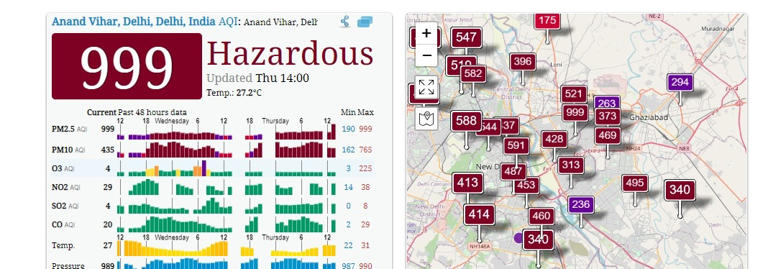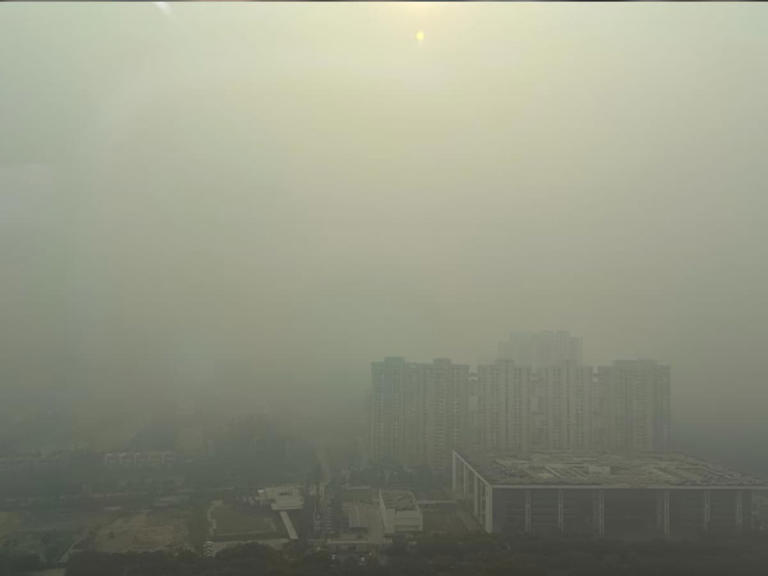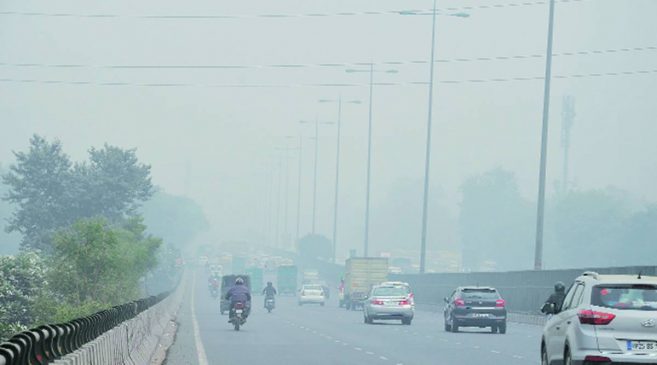The haze in the Thursday sky was so thick that it resembled the aftermath of an apocalypse. Even buildings across the road were barely visible due to the smog.
Many parts of Delhi recorded their air quality in the ‘hazardous’ zone on Thursday, with a persistent smoky haze blanketing the city for the third consecutive day.
Weather agency aqicn.org measured the air quality index in Delhi’s Anand Vihar at 999, while Noida’s Sector 62 logged 469. The AQI in many parts of Delhi was above 500, as per aqicn.org.

With a surge in farm fires and unfavorable weather conditions, scientists are cautioning about an anticipated rise in pollution levels in the Delhi-NCR region over the next two weeks. This is particularly worrisome given that the air quality index in many areas has already crossed the 400 mark.
Health experts are concerned about the potential increase in asthma and respiratory issues, particularly among children and the elderly.
As of 10 am (SAFAR data), the city’s Air Quality Index (AQI) was recorded at 351. The 24-hour average AQI stood at 364 on Wednesday, 359 on Tuesday, 347 on Monday, 325 on Sunday, 304 on Saturday, and 261 on Friday.
Various areas within the city, including Punjabi Bagh (416), Bawana (401), Mundka (420), and Anand Vihar (413), reported air quality falling into the severe category. The concentration of PM2.5, which comprises fine particulate matter capable of deeply penetrating the respiratory system upon inhalation, was six to seven times higher than the safe limit of 60 micrograms per cubic meter in these locations.
Delhi Environment Minister Gopal Rai on Wednesday said the city government will ban construction work in areas recording an air quality index (AQI) above the 400-mark for five consecutive days.

The government has launched “Red Light On Gaadi Off” to curb vehicular pollution and plans to hire 1,000 private CNG buses to strengthen public transport and reduce vehicular pollution.
The AQI was 230 in neighbouring Ghaziabad, 324 in Faridabad, 230 in Gurugram, 295 in Noida and 344 in Greater Noida.
An AQI between zero and 50 is considered good, 51 and 100 satisfactory, 101 and 200 moderate, 201 and 300 poor, 301 and 400 very poor, and 401 and 500 severe.
Read More: Govt allows direct listing of Indian companies on foreign exchanges
Unfavourable meteorological conditions and a cocktail of emissions from firecrackers and paddy straw burning, in addition to local sources of pollution, push the Delhi-NCR’s air quality to hazardous levels during winter.
According to an analysis conducted by the Delhi Pollution Control Committee (DPCC), the capital experiences peak pollution from November 1 to November 15, when the number of stubble burning incidents in Punjab and Haryana goes up.
The Punjab government is aiming to reduce farm fires by 50 per cent this winter season and eliminate stubble burning in six districts — Hoshiarpur, Malerkotla, Pathankot, Rupnagar, SAS Nagar (Mohali) and SBS Nagar.
According to the state’s action plan to curb paddy straw burning, about 31 lakh hectares of land in the state is under paddy cultivation. This is expected to generate around 16 million tonnes of paddy straw (non-basmati).
Haryana estimates that about 14.82 lakh hectares of land in the state is under paddy cultivation. This is expected to generate over 7.3 million tonnes of paddy straw (non-basmati). The state will attempt near elimination of farm fires this year.
According to a numerical model-based system developed by the Indian Institute of Tropical Meteorology (IITM) in Pune, vehicular emissions (11 per cent to 16 per cent) and stubble burning (seven per cent to 16 per cent) currently stand as the two major contributors to the city’s air quality.
(With inputs from PTI)

































